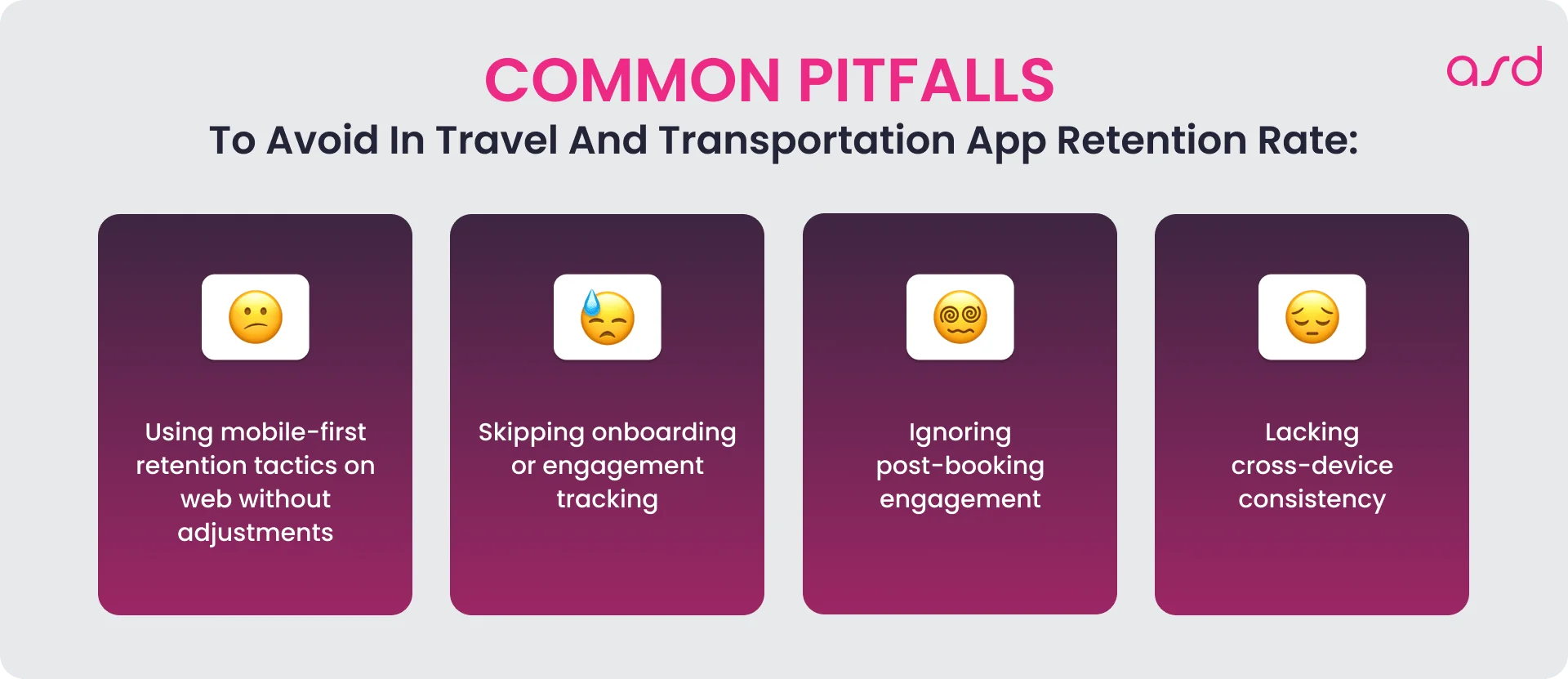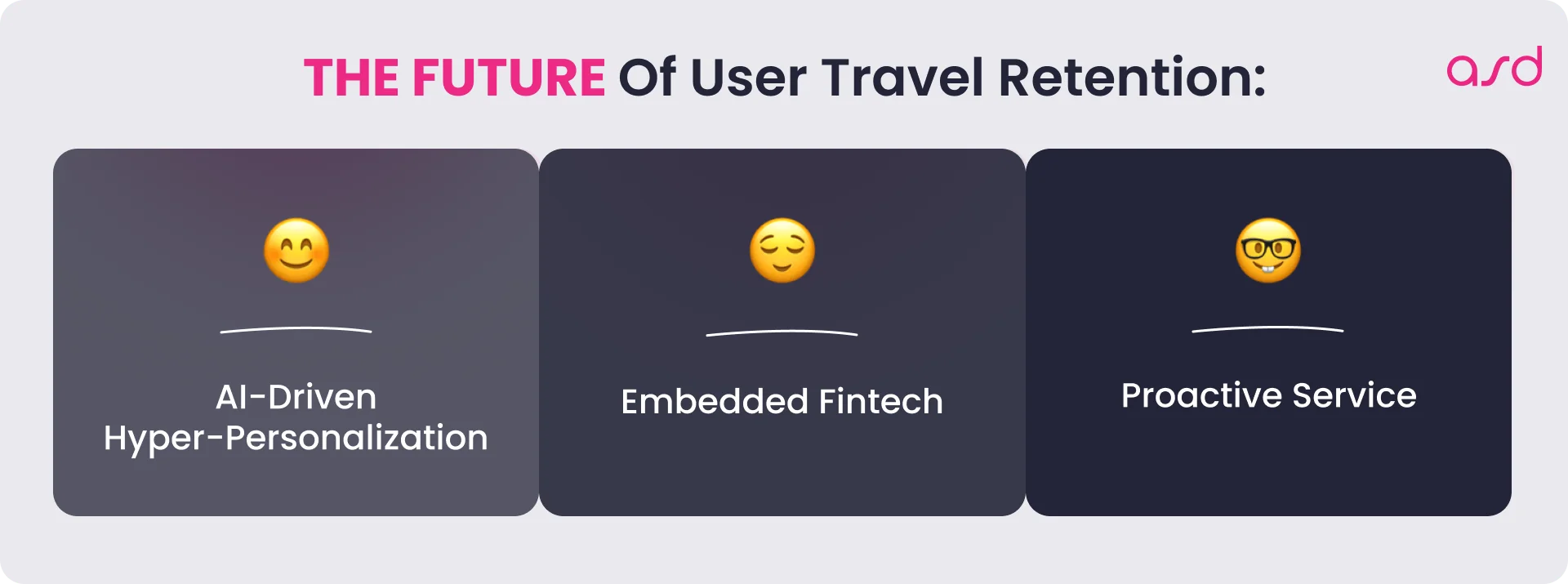Table of Content
- Understanding App Retention Metrics
- Why Users Churn: Reasons App User Retention Rate Fails
- 9 Ways to Improve Travel App Retention Rate
- Common Pitfalls to Avoid in Travel and Transportation App Retention Rate
- Focus on App User Retention Rate — Focus on a Long Game
- Retention Rate as Competitive Moats
We're building travel apps that users return to!
Book a callWhen you start a company, developing an app could be a very fun experience. Full of hope, the young CEO sees sweet dreams about being the most popular app on the App Store, or always number 1 in search engines, without ads, and making $ 10 million in revenue. And these are good goals, with actual, real potential. But, before you hit those goals, you should accomplish many steps, like churn reduction through a solid retention strategy. In this article, we`d like to give you 9 ways or tips to improve travel app user retention. As Travel Tech experts, we will focus on a travel app, nevertheless, you can easily adapt this guide to any industry.
User Retention Rate Is Your Product Strategy
In the travel industry, user retention isn’t just a metric—it’s a core product strategy. With travel and transportation app retention rate benchmarks among the lowest across app categories, and user sessions often months apart, keeping users engaged and loyal is a challenge that defines long-term growth. Whether you run a travel SaaS platform, a mobile booking app, or a web-based travel portal, your ability to improve travel app retention rate determines your competitive edge.
This article delivers actionable tips to improve travel app user retention for both mobile and web platforms. We’ll cover user onboarding, lifecycle messaging, cross-device engagement, and more—so you can build a product that travelers return to, not just once, but for every trip.
Understanding Travel and Transportation App Retention Metrics
Mobile App User Retention Benchmarks
- Day 1: Travel apps average an 18% retention rate on day one.
- Day 7: This drops to around 7.6%.
- Day 30: Only about 2.8% of users remain active after a month.
Web Platform Retention Benchmarks
Web travel platforms track return visits, bounce rate, and session length. While session frequency is lower than mobile, repeat visits and engagement with features like wishlists or saved searches are key signals.
What’s a Good App User Retention Rate?
For travel and transportation app retention rate, anything above 5% at day 30 is considered strong. Top performers push beyond 10% for loyal, repeat users.
Mobile vs Web Usage Patterns
Mobile apps see higher engagement during booking and trip periods, but web platforms often capture users in the research and planning phases. A successful retention strategy for SaaS travel products must bridge these patterns for cross-platform loyalty.
Why Users Churn: Reasons App User Retention Rate Fails

Understanding why users leave is the first step to reduce churn in travel platforms:
- Lack of value post-booking: Many travel apps focus on the transaction, not the journey, leaving users with no reason to return after booking.
- No user lifecycle strategy: Without lifecycle messaging or engagement, users forget about your platform between trips.
- Fragmented cross-device experience: Inconsistent UX between web and mobile frustrates users and drives churn.
- Technical issues: Slow load times, crashes, or billing errors can silently erode your retention rate.
- Not enough personalization: Users expect tailored recommendations and relevant content; generic experiences lead to app abandonment.
9 Ways to Improve Travel App Retention Rate
Build a Smooth User Onboarding Experience to Improve Travel App Retention Rate
Understanding travel SaaS user behavior, as well as web vs mobile usage patterns, is key to designing a frictionless onboarding process that boosts retention. Simplify registration flows, strategically highlight core features, and personalize the experience across mobile and web platforms. Tactics like interactive product tours, contextual tooltips, and optional/skippable onboarding steps directly address common drop-off points in travel SaaS user behavior, converting trial users into engaged customers, and increasing return visits to booking platforms from day one.
Learn more about how to create a roadmap for software development for effective product from day 1.
Deliver Personalized Travel Recommendations to Boost App User Retention
Personalization is a proven lever to improve travel app retention rate. Use data from trip history, preferences, and location to suggest relevant hotels, activities, and destinations. Implement personalized dashboards on web and real-time flows on mobile to make users feel understood and valued.
Use the Right Channel at the Right Time for App User Retention
Effective user retention strategies for mobile app and web platforms rely on lifecycle messaging, and push notifications vs email re-engagement contest:
- Push notifications: Great for timely, urgent updates (e.g., price drops, check-in reminders).
- Email re-engagement: Ideal for longer-term relationship building (e.g., trip inspiration, loyalty offers).
- Behavior-triggered messages: Use analytics to send targeted nudges based on user actions or inactivity.
Support Repeat Bookings & Habit Loops to Improve Travel App Retention Rate
Encourage habit formation by making repeat bookings effortless. Implement one-click rebooking, real-time booking updates, save frequent traveler preferences, and offer travel app loyalty features such as points, status tiers, or exclusive perks. Make sure these features work seamlessly across devices to increase return visits to booking platforms.
Real-Time UX + Cross-Device User Flow for Better Mobile App User Retention
Travelers expect real-time updates in travel apps: flight changes, gate alerts, or hotel check-in notifications. Ensure your platform offers a seamless cross-device user flow—users should be able to start a booking on the web and finish on mobile (or vice versa) without friction.
Speed & Performance Drive App User Retention Rate
Performance is non-negotiable. Optimize load times, reduce crashes, and streamline navigation to improve web app retention and mobile engagement. Even minor delays can increase bounce rates and churn, especially during high-stress travel moments.
Analytics and Lifecycle-Based Messaging for User Retention Strategies Mobile App
Leverage cohort tracking and lifecycle automation to deliver the right message at the right time. Use segmentation to identify at-risk users and trigger win-back campaigns. Apply SaaS product thinking—treat every user as a long-term relationship, not a one-time transaction.
Gamification & Community Features to Boost Travel App Retention Rate
Gamification elements like badges, challenges, or referral rewards can boost travel platform engagement. Community features—reviews, shared itineraries, or social sharing—foster a sense of belonging and increase the likelihood of repeat bookings.
Continuous Feedback & Iteration for Sustaining Mobile App User Retention
Regularly collect user feedback through in-app surveys or NPS prompts. Use insights to iterate on features, fix pain points, and demonstrate that you listen to your users. Continuous improvement is key to sustaining high mobile app user retention.

How a Platform Increased App User Retention Rate by 40%
One of our cliens—leading travel SaaS provider revamped its onboarding, introduced personalized trip recommendations, and unified its mobile and web UX. By implementing targeted lifecycle messaging and a loyalty program, they saw a 40% increase in user engagement in travel web apps and a significant drop in churn. The secret: treating retention as a product strategy, not just a metric.
Ready to Grow Loyalty? Partner with experts in travel app development and turn first-time users into loyal customers.

Common Pitfalls to Avoid in Travel and Transportation App Retention Rate
Many travel platforms undermine their retention efforts through avoidable mistakes. One critical error is applying mobile-first retention strategies to web platforms without adaptation – what works for a smartphone’s touch interface often fails on desktop browsers. Equally damaging is neglecting proper onboarding analytics and engagement tracking, leaving teams blind to where users drop off. Perhaps the most common oversight is failing to capitalize on post-booking engagement opportunities, despite this being the prime moment to cement loyalty. Finally, in an era where travelers routinely switch between devices, overlooking cross-device consistency creates frustrating experience gaps that drive users to competitors. These pitfalls collectively erode retention, but the good news is they’re all addressable with a focused strategy.

Focus on App User Retention Rate—Focus on a Long Game
Improving mobile app retention requires a focus on UX optimization, lifecycle engagement strategies, and cross-platform consistency. Top-performing apps prioritize repeat engagement, deliver value beyond core functionality (e.g., post-booking features), and ensure seamless user experiences across devices. To maximize long-term success, travel apps must adopt user retention strategies for mobile apps that blend these elements, creating sticky experiences that keep users coming back.
But retention isn’t just about tactics—it’s about mindset. The most successful travel platforms treat retention as a core product philosophy, not just a metric to optimize. They recognize that every interaction, from the first onboarding screen to post-trip follow-ups, is an opportunity to reinforce loyalty.
Why User Retention Rate Demands a Systemic Approach
The Compound Effect of Small Wins
A 5% improvement in onboarding completion or a 10% boost in repeat bookings might seem incremental, but over time, these gains compound into transformative growth. Example: A 40% retention increase (like the case study earlier) can double lifetime value (LTV) per user, turning break-even campaigns into profitable ones.
The Hidden Cost of Churn
- Acquiring a new travel app user costs 5–7x more than retaining an existing one. High churn erodes marketing ROI and forces unsustainable spend on re-acquisition.
- Loyal users also generate indirect value: referrals, positive reviews, and higher engagement with monetization features (e.g., ancillary bookings).
Seasonality as an Advantage
Travel is inherently seasonal, but retention strategies can turn this into a strength. Use off-peak periods to nurture users with:
- Personalized inspiration (e.g., “Bucket list trips for 2026”).
- Loyalty perks (e.g., “Book now for summer, earn double points”).
- Community content (e.g., user-generated itineraries).
The Future of User Travel Retention: Emerging Levers
-
AI-Driven Hyper-Personalization
Beyond basic recommendations, AI can predict user needs (e.g., suggesting airport transfers post-flight booking) or automate re-engagement (e.g., “Your usual hotel has a discount”).
-
Embedded Fintech
Travel wallets, BNPL options, or dynamic currency conversion can reduce friction and increase repeat usage.
-
Proactive Service
Anticipate disruptions (weather, strikes) and automate solutions (rebooking, refunds)—building trust that pays retention dividends.

Key Takeaways for Your Company
- Align retention goals company-wide
- Engineering, marketing, and CX teams should share retention KPIs (e.g., 30-day active users, repeat booking rate).
- Invest in analytics infrastructure
- Cohort analysis, churn prediction models, and A/B testing frameworks are non-negotiable for data-driven retention.
- Think beyond the “travel app”. Integrate with ecosystems (Google Travel, airline loyalty programs) to become indispensable, not just another icon on the home screen.
Retention Rate as Competitive Moats
In crowded markets like travel tech, features are easily copied, but retention systems are defensible advantages. A platform that masters cross-device habits, emotional engagement (e.g., trip memories), and frictionless utility will own its niche — regardless of competitors’ feature launches.
Ready to boost your retention? Partner with a team experienced in travel and hospitality software development and travel portal software development to build products users love.
Questions? Answers!
What is a good retention rate for a travel app (mobile and web)?
A good app user retention rate for travel apps is above 5% at day 30, with top performers reaching 10% or more. Mobile apps typically see 18% retention on day one, dropping to 2.8% by day 30. Web platforms focus on repeat visits and session length, with similar seasonal fluctuations.
How do travel apps increase user retention?
There are some tips to improve travel app user retention, leading platforms focus on smooth onboarding, personalized recommendations, real-time updates, loyalty features, and cross-device experiences. Lifecycle messaging—using push notifications and email, plus gamification and community features, is also a key strategy.
What causes high churn in travel SaaS platforms?
A lack of value post-booking, weak onboarding, fragmented mobile/web experiences, technical issues, and insufficient personalization often cause high churn. Addressing these issues with a robust user retention strategy can significantly reduce churn and increase return visits. To prevent this to happend at all is good to know how to choose software development partner, who code right the first time.
